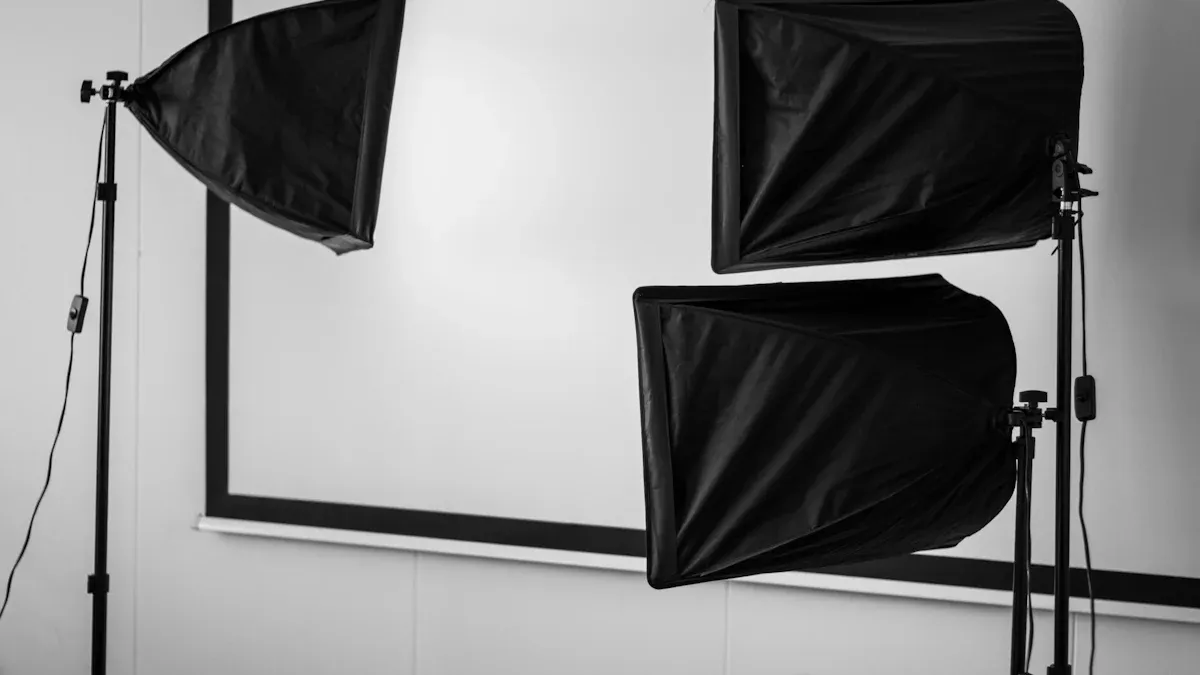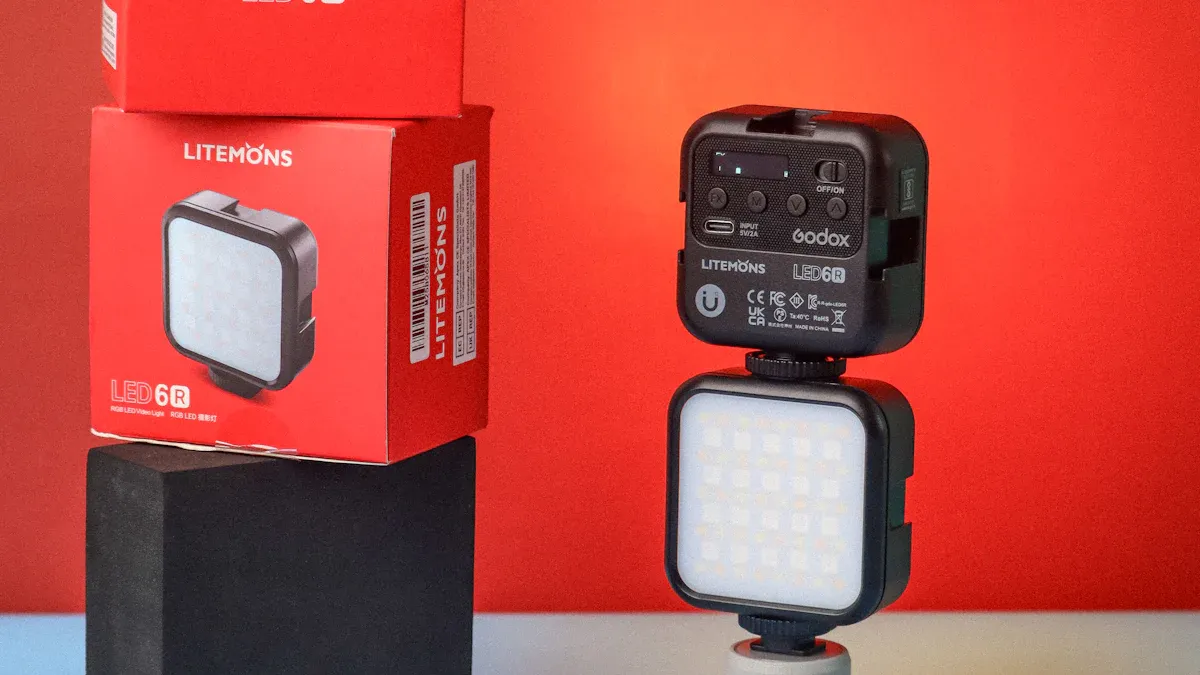Choosing the Best Lights for Your Light Box

If you want the best lights for your light box, choose high-efficiency LED strips or bulbs with a high color rendering index. You get more accurate colors and even lighting for your photos or displays.
A CRI above 95 keeps colors true and vivid.
Lower CRI causes color shifts and dull results.
Key Takeaways
Pick LED lights that use less energy for your light box. These lights help you save power. They also last a long time. LED lights show colors the right way.
Find lights with a Color Rendering Index (CRI) over 90. This helps your photos look like their real colors. Your displays will show true colors too.
Think about using battery-powered LEDs for setups you can move. These lights are simple to carry. You do not need to plug them in. This makes them useful in many places.
Best Lights for Light Boxes

When you want the best lights for your light box, you should think about energy use, color accuracy, and how easy it is to set up. Let’s look at the top lighting solutions so you can choose what fits your needs.
High-Efficiency LED Strips
High-efficiency LED strips are a great choice for the best lights. These lighting solutions use much less energy than older bulbs. The U.S. Department of Energy says LED bulbs use at least 75% less energy. They last 25 times longer than regular incandescent bulbs. You save money and don’t have to change bulbs often.
Here is a table with some popular brands and their features:
Brand | Features |
|---|---|
Cree LED | Long life, strong technology |
Nora Lighting | Wide range, advanced features |
WAC Lighting | Modern designs, smart options |
MaxximaStyle | Easy to install, affordable |
LEDs can save up to 90% in energy costs every year. They last between 25,000 to 35,000 hours. High-efficiency LED strips can last up to 50,000 hours. That means you can use them for 4 to 6 years, even if you use your light box every day. These lighting solutions also make very little heat. This keeps your setup safe and comfortable.
Tip: Pick LED strips with COB or CSP technology. They help with heat and make the lights work better.
Tungsten Bulbs with High CRI
Tungsten bulbs are another option for the best lights. They are good if you care about color accuracy. These bulbs have a CRI of 100, which is the highest rating. CRI means Color Rendering Index. It shows how well a light source displays the true colors of things. A CRI of 90 or higher is best for work like photography or art displays.
Here is a table that shows how CRI affects your results:
CRI Value | Color Accuracy | User Satisfaction |
|---|---|---|
90+ | High | High |
<80 | Low | Low |
Most people like natural and bright color rendering. High CRI bulbs are used in places like stores and galleries. Incandescent lamps, including tungsten bulbs, always give the best color rendering. If you want your photos or displays to look real, these lighting solutions are a good pick.
Note: Any CRI rating of 80 or more is high quality. Tungsten bulbs give the best results for color.
Battery-Operated LEDs
Sometimes you need lighting solutions that are easy to move and set up. Battery-operated LEDs are perfect for this. You don’t need wires or outlets, so you can use your light box anywhere. Here are some common battery types:
Rechargeable batteries like lithium-ion or NiMH are good for regular use.
Non-rechargeable batteries, such as alkaline, are good for emergencies. They last a long time on the shelf.
Alkaline batteries work best for low-power setups.
Nickel-Metal Hydride (NiMH) batteries have more energy and work in many LED lights.
Lithium batteries are the best for high-performance LED lights. They last longer.
Here is a table that shows how long different batteries last per charge:
Battery Type | Voltage | Capacity (mAh) | Typical Lifespan per Charge |
|---|---|---|---|
Coin Cell Battery | 3V | 220 | A few hours depending on bulbs |
1.5V AA/AAA Alkaline Battery | 1.5V | 1000 (AAA) / 2400 (AA) | Longer for AA, shorter for AAA |
9V Alkaline Battery | 9V | 500 | Not very long |
12V Rechargeable Lithium Battery | 12V | 20,000 | Lasts a long time because of high capacity |
Battery-operated LEDs are safe and easy to use. You don’t have to worry about electrical dangers. You can move your light box wherever you want. These lighting solutions are great for temporary setups or places without power outlets. But you might need to change batteries often. The brightness may not be as strong as wired options.
Pros:
No wires or outlets needed.
LEDs use less energy, even with batteries.
Easy to move and set up.
Fewer electrical risks.
Cons:
You may need to replace batteries often for bigger setups.
Not as bright as wired lighting solutions.
If you want the best lights for a portable or temporary light box, battery-operated LEDs are a smart choice.
Light Box Lighting Types

When you look at different types of electrical light boxes, you’ll notice that each uses a unique lighting setup. Let’s break down the main lighting styles so you can pick what works best for your needs.
Perimeter Lit
Perimeter lit light boxes use LED strips placed along the edges inside the frame. These strips shine sideways, so the light spreads across the display. Sometimes, you might see a glow at the corners. If you add a diffusion grid, the lighting becomes more even and helps avoid dark spots. This style works well for smaller displays or when you want a slim design.
Tip: Perimeter lit lighting can be dimmer and less uniform than other types. It’s a good choice if you need a simple setup or want to save space.
Full-Lit LED Solutions
Full-lit LED solutions cover all four sides of the light box. You get brighter and more even lighting. These panels use optical lenses to boost light projection, which makes your display pop. You’ll find that full-lit options are flexible and fit many sizes. Ultra-slim panels can squeeze into tight spaces. The dot matrix pattern spreads the light evenly, so your images look sharp.
Here’s a quick comparison:
Type of Lighting | Description | Brightness | Uniformity |
|---|---|---|---|
Full-Lit | Lighting along all four sides | Brighter | More even |
Half-Lit | Lighting along two sides | Dimmer | Less even |
Full-lit LED solutions give you:
Optimal display performance
High cost-effectiveness
Flexible sizing and design options
Diffused Fluorescent Lighting
Diffused fluorescent lighting uses tubes that spread light softly across the display. Most types of electrical light boxes with fluorescent lamps use cool white bulbs, which range from 4000 to 4400°K. You can upgrade to warmer or colder lamps if you want. Daylight bulbs reach up to 5500°K, giving you a crisp look. This lighting style helps reduce glare and keeps colors true.
Common Label | Color Temp. Range |
|---|---|
Kitchen & Bath | 2700 to 3500°K |
Cool White | 4000 to 4400°K |
Daylight | 5000 to 5500°K |
Most fluorescent lighting setups default to cool white.
You can request upgrades for warmer or colder color temperatures.
Daylight bulbs offer the coldest option for sharp displays.
Each lighting type fits different needs. Perimeter lit works for slim or portable boxes. Full-lit LED solutions shine in larger displays. Diffused fluorescent lighting is great for soft, even light and color control.
Choosing Lights for Light Box Photography
CRI and Color Accuracy
You want your photos to look real and vibrant. That’s why you should focus on the color rendering index, or CRI. For light box photography, the best CRI rating sits between 90 and 97. If you pick lighting with a CRI above 95, you’ll see true colors in your images. This matters a lot for product photography. When customers see accurate colors online, they trust your products more and return items less often. Museums and medical professionals also use high CRI lighting to keep colors honest and clear.
High CRI means:
Colors stay true in every shot.
Your products look the same online and in person.
Artists and photographers get consistent results.
Brightness and Wide-Angle Coverage
Brightness makes your photos pop. You need enough light to avoid shadows and dark spots. Wide-angle coverage helps spread the light evenly across your whole setup. Sometimes, images get darker near the edges, especially with wide-angle lenses. To fix this, choose lighting that gives uniform light from corner to corner. Your photos will look sharp and balanced.
Tip: Place your lights so they cover the entire field of view. This helps you avoid uneven lighting and keeps every part of your subject bright.
Energy Efficiency
You don’t want high energy bills or frequent bulb changes. Energy-efficient lighting is the smart choice. LED lightboxes use very little power and last a long time. MicroLED and OLED options also boost efficiency. If you switch from old bulbs to LED, you can save up to 60% on energy. LEDs use 90% less energy and last 25 times longer than traditional bulbs. Businesses can save thousands of dollars each year by upgrading to energy-efficient lighting.
Benefits of efficient lighting:
Lower costs
Less heat
Fewer replacements
Choosing the right lighting for light box photography means you get better photos, save money, and help the planet.
Electrical Light Box Installation
Ease of Installation
When you install your electrical light box, you want it to be easy. Gather all the tools you need before you start. This helps you work faster and makes things simple. Here’s a table to show what you should have:
Category | Tools/Accessories |
|---|---|
Basic Tools | Scissors, Soldering iron, Screwdriver, Wire strippers |
Installation Aids | Cleaning solution, Mounting clips, Pressure strips |
Electrical Components | LED power supply, Solderless connectors, Extension cables |
Control Components | LED dimmer, RGB controller, Smart module |
Check for loose wires so your lights don’t flicker. Look at the wiring if you see problems. Make sure your light box uses the right wattage for your lights. This stops overheating. Use mounting clips and pressure strips to hold everything in place.
If your LEDs are not lined up or your diffuser is not good, you might see bright spots or uneven light. Move the strips and get a better diffuser to fix this.
Compatibility and Safety
Your electrical light box needs the right lighting solutions. Heavy fixtures need strong ceiling boxes. Lighter ones can use regular boxes. Always follow safety rules and local codes when you install. Here are some safety tips:
Turn off the power at the breaker before you start.
Use waterproof connectors for outdoor setups.
Plug your light box into grounded outlets.
Explanation | |
|---|---|
Check State and Local Codes | Follow building codes and electrical rules. |
Switch Off the Power | Turn off the breaker so you don’t get shocked. |
Use Insulated Tools | Use tools with safe handles to protect yourself. |
Always check the weight and size of your lights before you install. This keeps your electrical light box safe and working well.
If you want your light box to work well, use high CRI LEDs or tungsten bulbs. These lights show colors the right way. Pick lighting that fits what you need. You might use your light box for photos, displays, or moving it around. Look at the table to see important things to think about. After that, check CRI ratings and learn how to install your lights for an easy upgrade.
Factor | Description |
|---|---|
Consistency | Even lighting makes your setup look pro. |
Portability | Simple to move and put together. |
Lighting | LEDs save energy and show colors clearly. |

Tip: Make a plan for your lights and check your wires to stay safe.
FAQ
How do you make sure your electrical light box meets safety standards?
Check the instructions from the maker. Always follow safety rules. Look at all the wires and connections. Test your light box before using it. If you are not sure, ask an expert for help.
What is the best way to save energy with your electrical light box?
Pick high-efficiency LEDs for your light box. Turn off the light box when you do not need it. Use timers to control when it turns on and off. Check your setup often for any problems. Using less energy saves you money.
Can you install electrical lighting in your light box by yourself?
You can do easy installation jobs yourself. Always read the instructions first. Follow all safety rules. If you see hard wiring, call a professional for help. Your safety is the most important thing.
Tip: Wear gloves and use insulated tools when you install lights. This helps keep you safe from electrical dangers.
Safety Checklist | Why It Matters |
|---|---|
Turn off power | Stops electric shocks |
Use safe tools | Keeps your hands safe |
Check wiring | Prevents fires |
See Also
Selecting Ideal Acrylic Panels for Your Light Box Displays
Choosing the Right Acrylic Sheet for Your Light Box
Finding the Best Wall Mount System for LED Light Boxes

